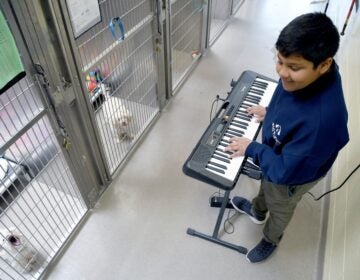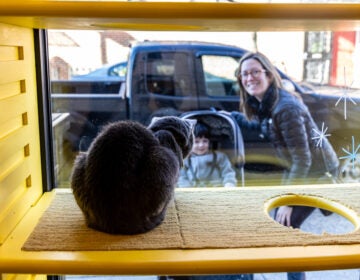Some New Jersey animal shelters say dogs are being left behind: Why Gen Z is adopting more cats over pups
While felines flourish, large dogs are facing longer stays and rising surrender rates.

Cat adoptions are on the rise in the Garden State. The outlook is considerably worse for shelter dogs. (The Humane Society of Atlantic County/Facebook)
From Philly and the Pa. suburbs to South Jersey and Delaware, what would you like WHYY News to cover? Let us know!
Fueled by Generation Z’s lifestyle, social values and housing realities, cat adoptions are climbing in New Jersey and reshaping the pet adoption landscape. But, behind the feel-good feline adoption trend lies a troubling gap: dogs, larger breeds in particular, are getting left behind in shelters.
According to the American Society for the Prevention of Cruelty to Animals 2024 U.S. Animal Shelter statistics, the length of time dogs are staying in shelters has jumped over the past five years.
“There is a crisis facing shelters in many parts of the country with their ability to adopt out dogs, especially larger ones,” said Brian Hackett, director of government and community relations of the Associated Humane Societies. “I think the primary contributor to the trend of dog adoptions being down is largely due to housing challenges.”
Hackett, who works with the state’s largest shelter network, said rising surrenders and longer shelter stays for dogs stem largely from a number of constraints, such as unaffordable home prices, evictions, higher vet fees, housing breed restrictions and limited pet-friendly rentals.

In Newark, his team sees the pattern regularly.
“You might adopt out 30 dogs in a week,” he said. “But in the next two weeks, that same number comes in through cruelty cases, bite holds, surrenders or abandonments. We can’t adopt our way out of the intake volume right now.”
Cats are being adopted at a record pace
In 2023, 3,001 cats were impounded and 2,321 were adopted in Camden County. That’s significantly higher than the 1,671 dogs impounded and 1,437 adopted during the same period, according to the New Jersey Department of Health. Statewide, the cat per-capita adoption rate was double that of dogs: 194 cats to 97 dogs per shelter.
National trends echo the same divide.
Shelter Animals Count reported a 2% rise in cat adoptions in 2024, with the overall cat adoption rate climbing to 64%. For the same time period, dog adoptions dropped 1%, nearly 22,000 fewer dogs adopted than the previous year. Dog adoptions have declined 13% since 2019.
Housing limitations, veterinary costs and return-to-office living
For many Gen Z and millennials, adopting cats makes sense. They require less space, can be left alone longer during the workday and are less likely to be subject to landlord or insurance restrictions.
“Cats fit the rhythm of Gen Z life,” said Laura Houston, executive director of the Animal Welfare Association in Voorhees. “You can live in a studio apartment, commute to work and still give your cat a good life. Try doing that with a 70-pound dog and a lease that says ‘no pets over 25 pounds.’”

Houston said dog adoptions at her shelter have decreased by about 25% and cat adoptions have increased by about 30%.
A 2024 Harris Poll found that 67% of Gen Z and young millennials prefer pets over children. Many of them are opting for cats because they view them as lower-maintenance family members: affordable, emotionally supportive and aesthetically compatible with small-space living.
“With the housing shortage, if [young people] are able to obtain a single-family home, they’d be lucky to be able to afford the expenses of a larger dog,” Hackett said. “The delay of being able to own your own home means they are living longer with parents or must settle for an apartment arrangement where, as a renter, they may face challenges.”
Cats, on the other hand, don’t come with the same hurdles and that makes them more accessible to younger renters and city dwellers.
“I never considered a dog,” said 21-year-old Gwen Wells of Florence. “I couldn’t take care of a dog while I was still in school and especially not now that I’m working full time. I don’t have a fenced-in yard, and I still live with my parents who’ve never owned a dog.”
Wells, who adopted her cat Charcoal, said she is glad she made that choice. “Charcoal is the perfect pet for me and my lifestyle right now and I’m sure a dog wouldn’t be as good of a fit as she is,” she said.

Houston and Hackett say more shelters are adopting creative solutions to make dogs more attractive for adoption. They are reducing adoption fees for large dogs, expanding foster programs and offering post-adoption training support to help prevent returns.
“We have had to have a greater focus on creative marketing of our dogs in hopes of increasing adoptions as well as soliciting for more fosters for adult dogs,” Houston said. “With the thought that being in foster will get them additional exposure to other potential adopters and give us more information on how they are in a home environment which will ultimately help with placement.”
Still, shelter leaders stress the need for better support for dog adoption, especially for larger breeds. They’re also pushing for broader policy changes at rental homes.
“I think it largely comes down to housing in many instances. Our shelter in Newark has seen a surge in abandonments and surrenders due to evictions and costs of veterinary care, “ Hackett said. “ Also, with the post-pandemic return-to-office trend, it is difficult for anyone, especially younger generations, to juggle all that a dog requires while being away for 8-10 hours each day.”
Educating the public is part of the solution. Many potential adopters don’t realize that not all large dogs require a lot of space or energy, she said, and some are even couch potatoes at heart.
“Big doesn’t mean difficult,” Houston said. “But we need to help people see that.”
New Jersey animal shelter resources
- Local animal shelters and rescues: AWA | Burlington County Animal Alliance | Homeward Bound | Humane Society of Ocean City | Tails of Hope
- Animals available for adoption: Dogs | Cats | Other
- Other resources: Low-cost spay/neuter | Report animal cruelty
WHYY News works with independent journalists in South Jersey to feature the people, communities, cultures and unique places that make up the Garden State. This work is supported by the Geraldine R. Dodge Foundation.

Get daily updates from WHYY News!
WHYY is your source for fact-based, in-depth journalism and information. As a nonprofit organization, we rely on financial support from readers like you. Please give today.




